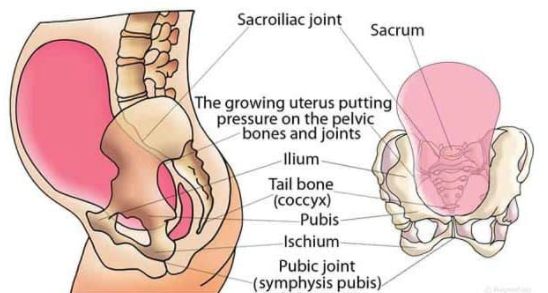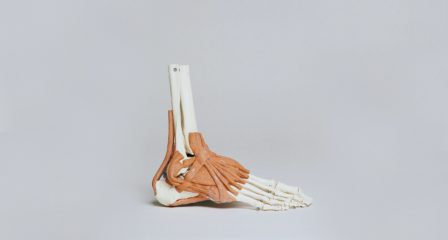Pregnancy is an interesting and unique time, during which, significant changes occur to a woman’s body. To adapt to the growing baby our bodies change the way they transfer load. The pelvis has been referred to as the ‘keystone’ of the body and is responsible for the transfer of load between the lower body and the trunk. The way the pelvis transfers load is forced to change during pregnancy and unfortunately this leads to approximately 50% of women experiencing pelvic pain during pregnancy.
WHY IS PELVIC PAIN ASSOCIATED WITH PREGNANCY?
Essentially, a woman’s body must change and grow to adapt to the growing baby. Our trunk, which includes the back, pelvis, abdomen and ribcage, has 85 muscles that work together to achieve dynamic stability. They guide and control movements at each of the joints.
When a woman is pregnant, there is a:
- Increase in weight: as the baby grows an average of 10kg is gained throughout the pregnancy.
- Change in weight distribution: due to the position of the uterus, there is increased weight placed anteriorly which changes the center of gravity.
- Changes to hormones: while there are many changes to hormones in pregnancy, the one most relevant to pelvic pain is relaxin. This hormone is designed to lengthen and relax ligaments to allow your baby to pass through the birth canal. There is a surge of relaxin in the first trimester which can cause lengthening of ligaments that provide stability to the pelvis.
- Lengthening of stability muscles (abdominals): again, as your baby grows, your ability to use your abdominal muscles reduces. As the abdominals play a key role in pelvic and trunk stability, when their ability to work is compromised, other muscles, ligaments and joints must work harder to compensate.
These four factors most commonly contribute to the development of pelvic pain in pregnancy. While these changes happen to all pregnant women, some are able to develop strategies that effectively compensate for these changes. Often when the compensatory strategies aren’t as effective, structures will become overloaded and that is when pain can develop.
WHAT CAN BE DONE TO HELP REDUCE PELVIC PAIN DURING PREGNANCY?
Due to the changes that happen during pregnancy (some of which are listed above), special care must be taken when treating pregnancy-related pelvic pain. In my opinion, the key to managing pelvic pain during pregnancy is early intervention. This may be something as simple as taking Panadol to relieve symptoms, or discussing your symptoms with your primary carer (midwife, GP or obstetrician) and seeking appropriate intervention. Studies in Australia have shown that 70% of women with pelvic pain report it to their primary carer, and only 25% seek treatment to manage these symptoms. It is important to note that while many of the factors that cause pelvic pain aren’t modifiable, there are some things that can be done to assist in the management of pelvic pain in pregnancy. These include;
- Strengthening exercises – are often the most effective form of treatment is exercise. If the correct exercises are prescribed, you will be able to engage muscles that have the capacity to improve stability of the pelvis and therefore reduce pain.
- Activity modification – while this is often not the most attractive option, modifying activity can be a simple and effective way to assist in pain management.
- Pelvic support belts – can be worn which help provide the compression that is lost with the loss of abdominal control. The downside of these is they are often uncomfortable to wear while sitting and they will often put some additional compression on the bladder (which is not needed during pregnancy!).
- Pregnancy support shorts – there are compression garments that have been designed specifically to aid in support during pregnancy. SRC (https://www.srchealth.com/) is one brand that has been specifically designed for the pregnant population to aid management of many pregnancy related symptoms including pelvic pain.
- Tape – while the belt and shorts can be beneficial, if you are towards the end of your pregnancy it may be more beneficial (financially) to trial taping techniques to support your pelvis. There are several taping techniques that can be used and are known to be effective.
- Manual therapy – manual therapies and massage can be effective to help provide short term relief and pain management in pelvic girdle pain. It is important to ensure the practitioner you see has experience in managing pregnancy as there are certain treatment methods that should be avoided during pregnancy.
WHY IS MANAGING PELVIC PAIN DURING PREGNANCY IMPORTANT?
As pregnancy is often uncomfortable even without pelvic pain, minimising any discomfort is an important factor. We also know that managing pelvic pain during pregnancy is important to ensure you manage well physically and emotionally post-partum.
IN SUMMARY…
One in two pregnant women will experience pregnancy-related pelvic pain. For majority of these women, it will be manageable and will settle early in the post-partum period. The most important thing to remember is there are treatment options and support garments which can assist in managing these symptoms. Seeking early advice and intervention is important, as while pelvic pain during pregnancy is common it can be managed and reduced. It is also often easier to establish a successful management plan before the pain becomes excessive.



